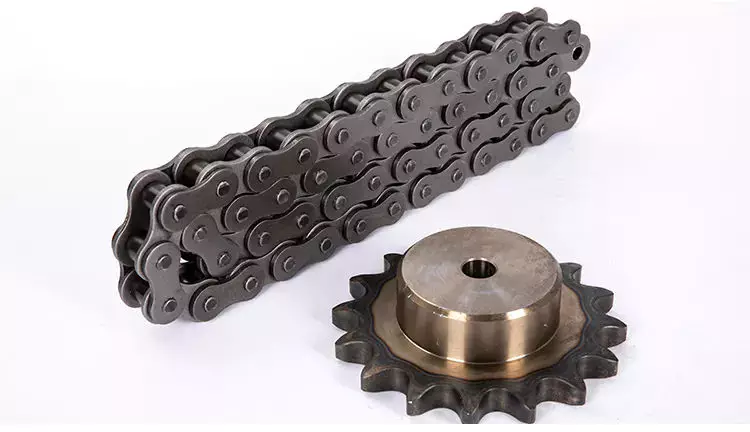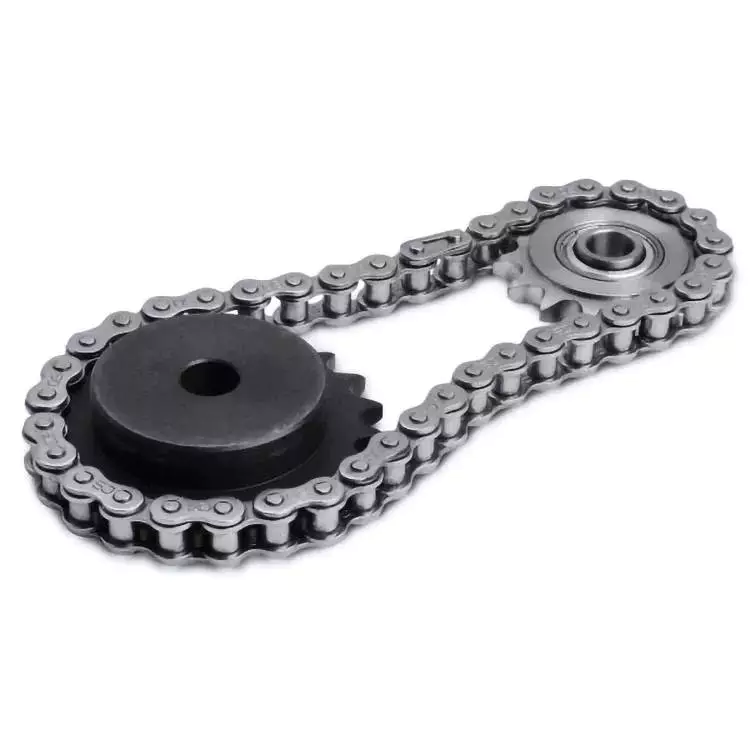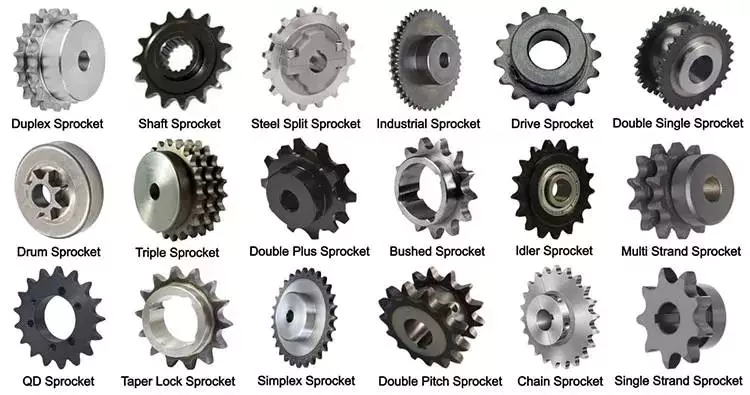Product Description
Product Description
RPI S323 Engine Timing Crankshaft Sprocket for BUICK CHEVROLET GMC JEEP OLDSMOBILE PONTIAC 25519954 with 20 Teeth
OE NO.: 25519954
Conditions: Brand New
Inside Diameter: 1.37″
Material: Metal
Outside Diameter: 2.38″
Thickness: 0.78″
Tooth Quantity: 20
Applications:
| MAKE | MODEL | YEAR | ENGINE |
|---|---|---|---|
| BUICK | APOLLO | 1973-1975 | V8 5.7L |
| BUICK | CENTURION | 1973 | V8 5.7L |
| BUICK | CENTURY | 1973-1977 | V8 5.7L |
| BUICK | CENTURY | 1975-1981, 1984-1985 | V6 3.8L |
| BUICK | CENTURY | 1978-1979 | V6 3.2L |
| BUICK | CENTURY | 1982-1985 | V6 3.0L |
| BUICK | ELECTRA | 1976-1980 | V8 5.7L |
| BUICK | ELECTRA | 1980-1984 | V6 4.1L |
| BUICK | ELECTRA | 1985 | V6 3.0L |
| BUICK | ELECTRA | 1985 | V6 3.8L |
| BUICK | ESTATE WAGON | 1973, 1978-1980 | V8 5.7L |
| BUICK | GRAN SPORT | 1967 | V8 5.6L |
| BUICK | GS | 1972 | V8 5.7L |
| BUICK | LESABRE | 1964-1965 | V8 4.9L |
| BUICK | LESABRE | 1966-1967 | V8 5.6L |
| BUICK | LESABRE | 1972-1980 | V8 5.7L |
| BUICK | LESABRE | 1976-1985 | V6 3.8L |
| BUICK | LESABRE | 1980-1984 | V6 4.1L |
| BUICK | REGAL | 1973-1977 | V8 5.7L |
| BUICK | REGAL | 1975-1987 | V6 3.8L |
| BUICK | REGAL | 1978-1979 | V6 3.2L |
| BUICK | REGAL | 1982-1984 | V6 4.1L |
| BUICK | RIVIERA | 1977-1978 | V8 5.7L |
| BUICK | RIVIERA | 1979-1985 | V6 3.8L |
| BUICK | RIVIERA | 1981-1984 | V6 4.1L |
| BUICK | SKYHAWK | 1975-1980 | V6 3.8L |
| BUICK | SKYLARK | 1961-1963 | V8 3.5L |
| BUICK | SKYLARK | 1964-1967 | V6 3.7L |
| BUICK | SKYLARK | 1964-1967 | V8 4.9L |
| BUICK | SKYLARK | 1966-1967 | V8 5.6L |
| BUICK | SKYLARK | 1972, 1975-1976 | V8 5.7L |
| BUICK | SKYLARK | 1975-1979 | V6 3.8L |
| BUICK | SPECIAL | 1961-1963 | V8 3.5L |
| BUICK | SPECIAL | 1962-1963 | V6 3.2L |
| BUICK | SPECIAL | 1964-1967 | V6 3.7L |
| BUICK | SPECIAL | 1964-1967 | V8 4.9L |
| BUICK | SPECIAL | 1966 | V8 5.6L |
| BUICK | SPORTWAGON | 1964 | V6 3.7L |
| BUICK | SPORTWAGON | 1964-1965 | V8 4.9L |
| BUICK | SPORTWAGON | 1966-1967 | V8 5.6L |
| BUICK | SPORTWAGON | 1972 | V8 5.7L |
| CADILLAC | DEVILLE | 1980-1982 | V6 4.1L |
| CADILLAC | ELDORADO | 1981-1982 | V6 4.1L |
| CADILLAC | FLEETWOOD | 1980-1982 | V6 4.1L |
| CADILLAC | SEVILLE | 1981-1982 | V6 4.1L |
| CHEVROLET | CAMARO | 1980-1981 | V6 3.8L |
| CHEVROLET | CAPRICE | 1980-1985 | V6 3.8L |
| CHEVROLET | EL CAMINO | 1978-1984 | V6 3.8L |
| CHEVROLET | IMPALA | 1980-1985 | V6 3.8L |
| CHEVROLET | MALIBU | 1978-1983 | V6 3.8L |
| CHEVROLET | MONTE CARLO | 1978-1985 | V6 3.8L |
| CHEVROLET | MONZA | 1978-1979 | V6 3.2L |
| CHEVROLET | MONZA | 1978-1980 | V6 3.8L |
| GMC | CABALLERO | 1978-1984 | V6 3.8L |
| JEEP | CJ3 | 1966 | L4 2.2L |
| JEEP | CJ3 | 1966 | V6 3.7L |
| JEEP | CJ5 | 1966-1967 | L4 2.2L |
| JEEP | CJ5 | 1966-1971 | V6 3.7L |
| JEEP | CJ6 | 1966-1967 | L4 2.2L |
| JEEP | CJ6 | 1966-1971 | V6 3.7L |
| JEEP | COMMANDO | 1966 | L4 2.2L |
| JEEP | COMMANDO | 1966-1967 | V6 3.7L |
| JEEP | DISPATCHER | 1966-1967 | V6 3.7L |
| JEEP | DJ5 | 1966 | L4 2.2L |
| JEEP | DJ5 | 1966 | L4 3.2L |
| JEEP | DJ5 | 1966-1970 | V6 3.7L |
| JEEP | DJ6 | 1966-1967 | L4 2.2L |
| JEEP | DJ6 | 1966-1967 | L4 3.2L |
| JEEP | DJ6 | 1966-1968 | V6 3.7L |
| JEEP | FC150 | 1966 | V6 3.7L |
| JEEP | J-100 | 1969-1971 | V8 5.7L |
| JEEP | J-2500 | 1969-1971 | V8 5.7L |
| JEEP | J-2600 | 1969-1970 | V8 5.7L |
| JEEP | J-2700 | 1969-1970 | V8 5.7L |
| JEEP | J-2700 | 1970 | V8 5.3L |
| JEEP | J-3500 | 1969-1970 | V8 5.7L |
| JEEP | J-3600 | 1969-1970 | V8 5.7L |
| JEEP | J-3700 | 1969-1970 | V8 5.7L |
| JEEP | J-3800 | 1969-1970 | V8 5.3L |
| JEEP | J-3800 | 1969-1970 | V8 5.7L |
| JEEP | JEEPSTER | 1966 | L4 2.2L |
| JEEP | JEEPSTER | 1966-1971 | V6 3.7L |
| JEEP | UNIVERSAL | 1966-1967 | V6 3.7L |
| JEEP | WAGONEER | 1971 | V8 5.7L |
| OLDSMOBILE | 98 | 1977-1980 | V8 5.7L |
| OLDSMOBILE | 98 | 1981-1983 | V6 4.1L |
| OLDSMOBILE | 98 | 1985 | V6 3.0L |
| OLDSMOBILE | 98 | 1985 | V6 3.8L |
| OLDSMOBILE | CUSTOM CRUISER | 1977-1980 | V8 5.7L |
| OLDSMOBILE | CUTLASS | 1962-1963 | V8 3.5L |
| OLDSMOBILE | CUTLASS | 1975-1980 | V8 5.7L |
| OLDSMOBILE | CUTLASS | 1977-1981 | V6 3.8L |
| OLDSMOBILE | CUTLASS CALAIS | 1978-1984 | V6 3.8L |
| OLDSMOBILE | CUTLASS CALAIS | 1979-1980 | V8 5.7L |
| OLDSMOBILE | CUTLASS CIERA | 1982-1985 | V6 3.0L |
| OLDSMOBILE | CUTLASS CIERA | 1984-1985 | V6 3.8L |
| OLDSMOBILE | CUTLASS CRUISER | 1980-1983 | V6 3.8L |
| OLDSMOBILE | CUTLASS CRUISER | 1980 | V8 5.7L |
| OLDSMOBILE | CUTLASS SALON | 1975-1977, 1979-1980 | V8 5.7L |
| OLDSMOBILE | CUTLASS SALON | 1978-1980, 1985 | V6 3.8L |
| OLDSMOBILE | CUTLASS SUPREME | 1975-1980 | V8 5.7L |
| OLDSMOBILE | CUTLASS SUPREME | 1977-1985 | V6 3.8L |
| OLDSMOBILE | CUTLASS TIARA | 1976 | V8 5.7L |
| OLDSMOBILE | DELTA 88 | 1975-1980 | V8 5.7L |
| OLDSMOBILE | DELTA 88 | 1977-1985 | V6 3.8L |
| OLDSMOBILE | F85 | 1961-1963 | V8 3.5L |
| OLDSMOBILE | F85 | 1964-1965 | V6 3.7L |
| OLDSMOBILE | JETFIRE | 1962-1963 | V8 3.5L |
| OLDSMOBILE | OMEGA | 1975-1976 | L6 4.1L |
| OLDSMOBILE | OMEGA | 1975-1979 | V8 5.7L |
| OLDSMOBILE | OMEGA | 1977-1979 | V6 3.8L |
| OLDSMOBILE | STARFIRE | 1975-1980 | V6 3.8L |
| OLDSMOBILE | TORONADO | 1979-1980 | V8 5.7L |
| OLDSMOBILE | TORONADO | 1981-1984 | V6 4.1L |
| OLDSMOBILE | VISTA CRUISER | 1975 | V8 5.7L |
| PONTIAC | BONNEVILLE | 1978-1980 | V8 5.7L |
| PONTIAC | BONNEVILLE | 1982 | V6 4.1L |
| PONTIAC | CATALINA | 1977, 1980 | V6 3.8L |
| PONTIAC | CATALINA | 1978-1980 | V8 5.7L |
| PONTIAC | FIREBIRD | 1977 | V6 3.8L |
| PONTIAC | FIREBIRD | 1978-1979 | V8 5.7L |
| PONTIAC | GRAND AM | 1975 | V8 5.7L |
| PONTIAC | GRAND LEMANS | 1975 | L6 4.1L |
| PONTIAC | GRAND LEMANS | 1975-1979 | V8 5.7L |
| PONTIAC | GRAND LEMANS | 1977, 1979-1983 | V6 3.8L |
| PONTIAC | GRAND LEMANS | 1982 | V6 4.1L |
| PONTIAC | GRAND PRIX | 1979 | V6 3.8L |
| PONTIAC | GRAND PRIX | 1982 | V6 4.1L |
| PONTIAC | LAURENTIAN | 1978-1980 | V8 5.7L |
| PONTIAC | LAURENTIAN | 1980-1981 | V6 3.8L |
| PONTIAC | LEMANS | 1975 | L6 4.1L |
| PONTIAC | LEMANS | 1975-1979 | V8 5.7L |
| PONTIAC | LEMANS | 1977, 1979-1981 | V6 3.8L |
| PONTIAC | PARISIENNE | 1976, 1978-1980 | V8 5.7L |
| PONTIAC | PARISIENNE | 1980-1983, 1985 | V6 3.8L |
| PONTIAC | PHOENIX | 1977 | V6 3.8L |
| PONTIAC | PHOENIX | 1977-1979 | V8 5.7L |
| PONTIAC | SUNBIRD | 1976-1977 | V6 3.8L |
| PONTIAC | TEMPEST | 1961-1962 | V8 3.5L |
| PONTIAC | VENTURA | 1975-1976 | L6 4.1L |
| PONTIAC | VENTURA | 1975-1977 | V8 5.7L |
| PONTIAC | VENTURA | 1977 | V6 3.8L |
Detailed Photos
Certifications
Packaging & Shipping
1. Standard Exporting package
2. Original package or neutral package.
3. According to clients ‘ needs
4.Each product will be packed with individual box, and boxes will be packed with carton, heavy parts will be packed with wooden box.
Company Profile
FAQ
| Certification: | TS16949 |
|---|---|
| Standard Component: | Standard Component |
| Technics: | Casting |
| Material: | Iron |
| Type: | Engine Timing Crankshaft Sprocket |
| Inside Diameter: | 1.37" |
| Customization: |
Available
| Customized Request |
|---|

How to Identify a Sprocket
When choosing a sprocket, you have several options. There are several types, each with unique features. In this article, we’ll discuss how to identify sprockets, and how to replace worn or damaged sprockets.
buy sprockets
When building a bicycle, sprockets are an important part of the drivetrain. Unfortunately, they’re hard to find outside of places like CZPT. Fortunately, there are some easy ways to find the right sprocket for your bike.
The first thing to consider is what kind of sprocket you need. Choosing the wrong sprocket can damage your equipment or cause it to fail prematurely. While sprockets come in a variety of sizes, there are some key features that can help you find the right one.
There are two basic types of sprockets. You can choose one made of steel or aluminum, or a combination of both. Most sprockets are made of steel, but there are also new aluminum sprockets that are similar to steel and last as long as steel. No matter which material you choose, it’s important to choose a reputable manufacturer with regular maintenance.
Buying sprockets that match your chain is another way to ensure proper installation. The chain goes through the sprockets thousands of times per minute, so the teeth eventually wear out. Poorly maintained sprockets can also cause “hook” teeth, which will cause your chain to stretch to the point where you can no longer adjust it.
Identify sprockets
One of the most common bicycle parts is the sprocket, which can be identified by its width and number of teeth. A single sprocket has one tooth along its circumference, while a double sprocket has two rows of teeth. Sprockets are also known by different names, including single, double, triple, and quadruple sprockets.
Roller sprockets are another type of sprocket. It runs along a chain of rollers connected by pins. It fits into the gap between the rollers in the chain to transfer kinetic energy. There are two basic styles of roller sprockets: single pitch and double pitch. Single-pitch sprockets are small and fit snugly against the equipment, while double-pitch sprockets are larger and require more thickness to support the weight.
Checking a sprocket is easy if you know how to count teeth. A simple caliper will allow you to easily find sprockets with worn teeth. Calipers also allow you to measure the hole of the sprocket, which is the inside diameter of the sprocket.
Another way to tell if a sprocket is worn is to visually inspect the sprocket. Worn sprockets can cause the chain to bounce, putting more pressure on the bearings and accelerating wear. It is also important to check the alignment of the sprockets. If it’s off center, it probably means the chain needs to be replaced.
Replace sprocket
If you want to maintain your bike, it’s a good idea to replace your chain and sprockets regularly. If you don’t, you may have a problem that will only get worse. Worn chains can also make noise, so it’s a good idea to check them regularly. Also, you should lubricate and tighten them regularly, especially when they reach their maximum mileage.
First, you need to determine the size of the chain. Usually, you’ll find it in the manual. Common sizes are 520, 525, and 530. The first number refers to the pitch of the chain, which is the distance between the rivets, while the second number refers to the width of the sprocket. For example, a 20-tooth sprocket is two and a half inches wide.
Replacing a sprocket is a relatively simple process. Be sure to clean the bike and apply wheel bearing grease before tackling the task. Next, remove the old chain from the rear wheel. Some bikes may have clevises or side panels that need to be removed. A flat-blade screwdriver works well for this problem. You can also use the Broken Links tool to remove split links.
You can also install new sprockets on your bike. After removing the old one, be sure to follow the manufacturer’s instructions for chain and sprocket size. You should also tighten the sprocket nut to the manufacturer’s torque setting. Once you’ve done this, be sure to check the chain tension to make sure it’s not too loose or too tight.
Replace worn chains
To prevent damage to the chain, the chain must be replaced regularly. It’s prone to wear and tear, but you can extend the life of your bike’s chain with a few simple steps. One of the steps is to lift the rear wheel of the bike so you can run the new chain through the rear derailleur. This will make the task easier because your bike won’t be lying on the floor. If you don’t have a bike rack, you can use cinder blocks, wood, or boxes to support your bike rack.
The most obvious sign is yIf your chain bounces under load, our chainrings need to be replaced. Using a chain gauge will let you know when you need a new chain. Chain gauges usually consist of two sides and are used to measure the amount of wear on the chain under a given load. You can check the gauge by placing it on the chain and making sure it sinks into the chain.
First, you need to delete the old chain. Some older chains use uniform pins that you can use to replace them. Make sure to get a chain that is the same length as the old one. Also, pay attention to the type of drivetrain your bike has. For example, if it has a rear derailleur, you will need a chain that matches the same drivetrain.
Check the sprocket for rust
One of the best ways to check your bike for rust is to look for surface rust. This is the first sign that the metal is starting to oxidize. Using a steel brush to remove surface rust is a good idea, but be sure to wear safety glasses. You can also clean the sprockets with WD-40 or kerosene.
Another indicator that a sprocket needs to be replaced is excessive wear. This may be caused by foreign objects conveyed by the chain. It may also be necessary to center the chain and drive sprocket and install guide rollers. Other signs of sprocket rust include excessive vibration due to improperly machined axle holes or a bent or bent chain.
You should also look for any kinks in the chain. If so, you may need to replace the chain. Also, look for any rust spots and excess grease. Also, you should check the sprockets to make sure they are properly aligned.
Besides rust, another sign of rust is the chain jumping out of the sprocket. This can cause the chain to jam and cause your bike to slip. This situation is also dangerous for you and other drivers.
Replace worn sprockets
You can repair your bike’s gears by replacing the sprockets. You should always check the chain for any signs of wear. In the case of a worn sprocket, you should check the teeth, which are usually tall and hooked.
If the sprocket is curled, skewed, or uneven, the sprocket is worn and needs to be replaced. If the sprockets are not replaced, they will wear out the chain very quickly. Chains should be replaced as soon as they show signs of excessive wear.
To replace a worn sprocket, you must first remove the old rear sprocket. To do this, loosen the bolts that hold the sprocket in place. You should also clean the hub surface with steel wool to reduce corrosion and wear.
Worn sprockets have worn teeth that keep the roller chain from slipping. This can cause the chain to climb up the sprockets and make a lot of noise. In addition to noise, chains can stick to worn sprockets and damage sprockets and chain. Don’t wait until the chain is out of control to fix it.
After the sprocket is removed, the rear sprocket and drive sprocket can be replaced. It is important to check the alignment of the sprockets, as incorrect alignment can cause premature chain wear. Proper alignment will distribute the load evenly across the entire width of the chain, extending the life of the chain. You can check the sprocket with a ruler or laser sight tool.


editor by CX 2023-05-29